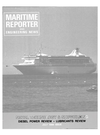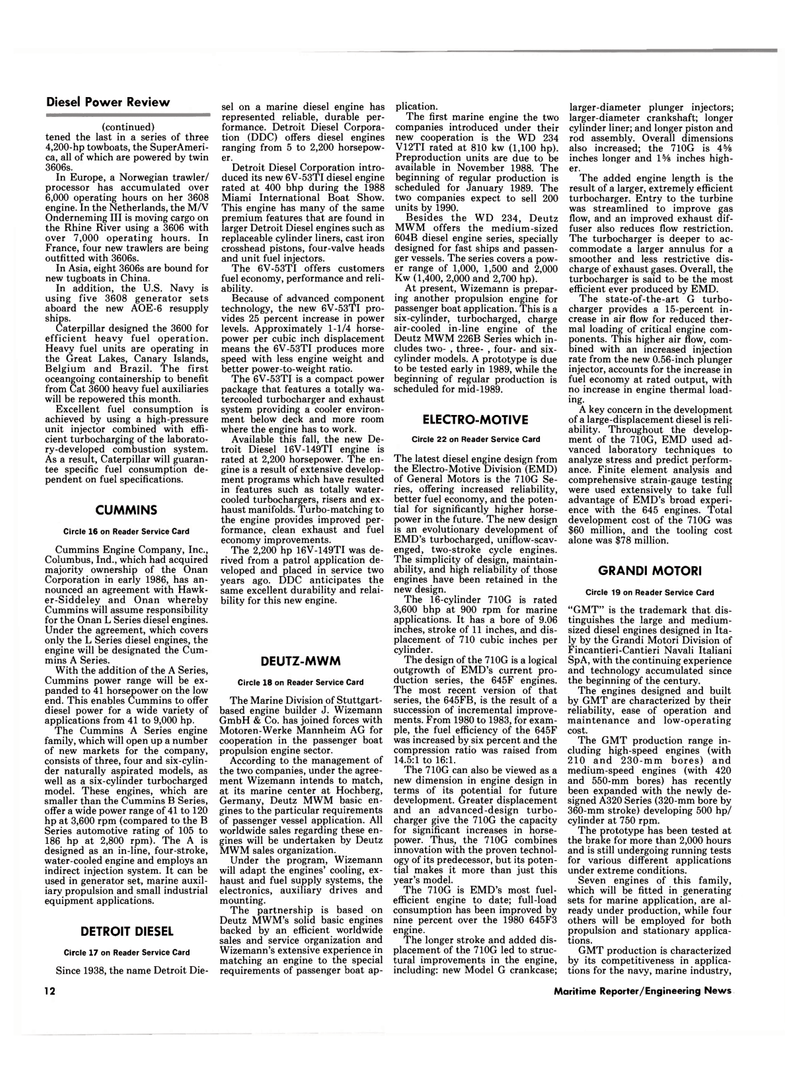
Page 10: of Maritime Reporter Magazine (July 1988)
Read this page in Pdf, Flash or Html5 edition of July 1988 Maritime Reporter Magazine
Diesel Power Review (continued) tened the last in a series of three 4,200-hp towboats, the SuperAmeri- ca, all of which are powered by twin 3606s.
In Europe, a Norwegian trawler/ processor has accumulated over 6,000 operating hours on her 3608 engine. In the Netherlands, the M/V
Onderneming III is moving cargo on the Rhine River using a 3606 with over 7,000 operating hours. In
France, four new trawlers are being outfitted with 3606s.
In Asia, eight 3606s are bound for new tugboats in China.
In addition, the U.S. Navy is using five 3608 generator sets aboard the new AOE-6 resupply ships.
Caterpillar designed the 3600 for efficient heavy fuel operation.
Heavy fuel units are operating in the Great Lakes, Canary Islands,
Belgium and Brazil. The first oceangoing containership to benefit from Cat 3600 heavy fuel auxiliaries will be repowered this month.
Excellent fuel consumption is achieved by using a high-pressure unit injector combined with effi- cient turbocharging of the laborato- ry-developed combustion system.
As a result, Caterpillar will guaran- tee specific fuel consumption de- pendent on fuel specifications.
CUMMINS
Circle 16 on Reader Service Card
Cummins Engine Company, Inc.,
Columbus, Ind., which had acquired majority ownership of the Onan
Corporation in early 1986, has an- nounced an agreement with Hawk- er-Siddeley and Onan whereby
Cummins will assume responsibility for the Onan L Series diesel engines.
Under the agreement, which covers only the L Series diesel engines, the engine will be designated the Cum- mins A Series.
With the addition of the A Series,
Cummins power range will be ex- panded to 41 horsepower on the low end. This enables Cummins to offer diesel power for a wide variety of applications from 41 to 9,000 hp.
The Cummins A Series engine family, which will open up a number of new markets for the company, consists of three, four and six-cylin- der naturally aspirated models, as well as a six-cylinder turbocharged model. These engines, which are smaller than the Cummins B Series, offer a wide power range of 41 to 120 hp at 3,600 rpm (compared to the B
Series automotive rating of 105 to 186 hp at 2,800 rpm). The A is designed as an in-line, four-stroke, water-cooled engine and employs an indirect injection system. It can be used in generator set, marine auxil- iary propulsion and small industrial equipment applications.
DETROIT DIESEL
Circle 17 on Reader Service Card
Since 1938, the name Detroit Die- sel on a marine diesel engine has represented reliable, durable per- formance. Detroit Diesel Corpora- tion (DDC) offers diesel engines ranging from 5 to 2,200 horsepow- er.
Detroit Diesel Corporation intro- duced its new 6V-53TI diesel engine rated at 400 bhp during the 1988
Miami International Boat Show.
This engine has many of the same premium features that are found in larger Detroit Diesel engines such as replaceable cylinder liners, cast iron crosshead pistons, four-valve heads and unit fuel injectors.
The 6V-53TI offers customers fuel economy, performance and reli- ability.
Because of advanced component technology, the new 6V-53TI pro- vides 25 percent increase in power levels. Approximately 1-1/4 horse- power per cubic inch displacement means the 6V-53TI produces more speed with less engine weight and better power-to-weight ratio.
The 6V-53TI is a compact power package that features a totally wa- tercooled turbocharger and exhaust system providing a cooler environ- ment below deck and more room where the engine has to work.
Available this fall, the new De- troit Diesel 16V-149TI engine is rated at 2,200 horsepower. The en- gine is a result of extensive develop- ment programs which have resulted in features such as totally water- cooled turbochargers, risers and ex- haust manifolds. Turbo-matching to the engine provides improved per- formance, clean exhaust and fuel economy improvements.
The 2,200 hp 16V-149TI was de- rived from a patrol application de- veloped and placed in service two years ago. DDC anticipates the same excellent durability and relai- bility for this new engine.
DEUTZ-MWM
Circle 18 on Reader Service Card
The Marine Division of Stuttgart- based engine builder J. Wizemann
GmbH & Co. has joined forces with
Motoren-Werke Mannheim AG for cooperation in the passenger boat propulsion engine sector.
According to the management of the two companies, under the agree- ment Wizemann intends to match, at its marine center at Hochberg,
Germany, Deutz MWM basic en- gines to the particular requirements of passenger vessel application. All worldwide sales regarding these en- gines will be undertaken by Deutz
MWM sales organization.
Under the program, Wizemann will adapt the engines' cooling, ex- haust and fuel supply systems, the electronics, auxiliary drives and mounting.
The partnership is based on
Deutz MWM's solid basic engines backed by an efficient worldwide sales and service organization and
Wizemann's extensive experience in matching an engine to the special requirements of passenger boat ap- plication.
The first marine engine the two companies introduced under their new cooperation is the WD 234
V12TI rated at 810 kw (1,100 hp).
Preproduction units are due to be available in November 1988. The beginning of regular production is scheduled for January 1989. The two companies expect to sell 200 units by 1990.
Besides the WD 234, Deutz
MWM offers the medium-sized 604B diesel engine series, specially designed for fast ships and passen- ger vessels. The series covers a pow- er range of 1,000, 1,500 and 2,000
Kw (1,400, 2,000 and 2,700 hp).
At present, Wizemann is prepar- ing another propulsion engine for passenger boat application. This is a six-cylinder, turbocharged, charge air-cooled in-line engine of the
Deutz MWM 226B Series which in- cludes two- , three- , four- and six- cylinder models. A prototype is due to be tested early in 1989, while the beginning of regular production is scheduled for mid-1989.
ELECTRO-MOTIVE
Circle 22 on Reader Service Card
The latest diesel engine design from the Electro-Motive Division (EMD) of General Motors is the 710G Se- ries, offering increased reliability, better fuel economy, and the poten- tial for significantly higher horse- power in the future. The new design is an evolutionary development of
EMD's turbocharged, uniflow-scav- enged, two-stroke cycle engines.
The simplicity of design, maintain- ability, and high reliability of those engines have been retained in the new design.
The 16-cylinder 710G is rated 3,600 bhp at 900 rpm for marine applications. It has a bore of 9.06 inches, stroke of 11 inches, and dis- placement of 710 cubic inches per cylinder.
The design of the 710G is a logical outgrowth of EMD's current pro- duction series, the 645F engines.
The most recent version of that series, the 645FB, is the result of a succession of incremental improve- ments. From 1980 to 1983, for exam- ple, the fuel efficiency of the 645F was increased by six percent and the compression ratio was raised from 14.5:1 to 16:1.
The 710G can also be viewed as a new dimension in engine design in terms of its potential for future development. Greater displacement and an advanced-design turbo- charger give the 710G the capacity for significant increases in horse- power. Thus, the 710G combines innovation with the proven technol- ogy of its predecessor, but its poten- tial makes it more than just this year's model.
The 710G is EMD's most fuel- efficient engine to date; full-load consumption has been improved by nine percent over the 1980 645F3 engine.
The longer stroke and added dis- placement of the 710G led to struc- tural improvements in the engine, including: new Model G crankcase; larger-diameter plunger injectors; larger-diameter crankshaft; longer cylinder liner; and longer piston and rod assembly. Overall dimensions also increased; the 710G is 4% inches longer and 1% inches high- er.
The added engine length is the result of a larger, extremely efficient turbocharger. Entry to the turbine was streamlined to improve gas flow, and an improved exhaust dif- fuser also reduces flow restriction.
The turbocharger is deeper to ac- commodate a larger annulus for a smoother and less restrictive dis- charge of exhaust gases. Overall, the turbocharger is said to be the most efficient ever produced by EMD.
The state-of-the-art G turbo- charger provides a 15-percent in- crease in air flow for reduced ther- mal loading of critical engine com- ponents. This higher air flow, com- bined with an increased injection rate from the new 0.56-inch plunger injector, accounts for the increase in fuel economy at rated output, with no increase in engine thermal load- ing.
A key concern in the development of a large-displacement diesel is reli- ability. Throughout the develop- ment of the 710G, EMD used ad- vanced laboratory techniques to analyze stress and predict perform- ance. Finite element analysis and comprehensive strain-gauge testing were used extensively to take full advantage of EMD's broad experi- ence with the 645 engines. Total development cost of the 710G was $60 million, and the tooling cost alone was $78 million.
GRANDI MOTORI
Circle 19 on Reader Service Card "GMT" is the trademark that dis- tinguishes the large and medium- sized diesel engines designed in Ita- ly by the Grandi Motori Division of
Fincantieri-Cantieri Navali Italiani
SpA, with the continuing experience and technology accumulated since the beginning of the century.
The engines designed and built by GMT are characterized by their reliability, ease of operation and maintenance and low-operating cost.
The GMT production range in- cluding high-speed engines (with 210 and 230-mm bores) and medium-speed engines (with 420 and 550-mm bores) has recently been expanded with the newly de- signed A320 Series (320-mm bore by 360-mm stroke) developing 500 hp/ cylinder at 750 rpm.
The prototype has been tested at the brake for more than 2,000 hours and is still undergoing running tests for various different applications under extreme conditions.
Seven engines of this family, which will be fitted in generating sets for marine application, are al- ready under production, while four others will be employed for both propulsion and stationary applica- tions.
GMT production is characterized by its competitiveness in applica- tions for the navy, marine industry, 12 Maritime Reporter/Engineering News

 9
9

 11
11
